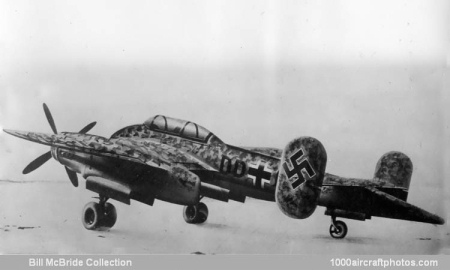The first prototype, the Ar 240 V1, was completed as a fighter/dive-bomber powered by two 1,175 hp DB 601A engines, and flew on June 25, 1940. Automatic slots were fitted to the wing leading edges, and a four-ribbed "umbrella" type dive brake was attached to the extreme rear fuselage. It was joined by the Ar 240 V2 in August 1940, this differing from its predecessor solely in having a forward-firing armament of two 0.311 in (7.9 mm) MG 17 guns in the wing roots and two 0.787 in (20 mm) MG 151 cannon in the fuselage, neither machine having the remotely-controlled barbettes which were under test on a Bf 110C.
The Ar 240 proved to possess appallingly bad handling characteristics and to be completely unstable, and extensive redesign of the fuselage was obviously necessary. This redesign was incorporated in the Ar 240 V3, in which the cockpit was pressurized and moved forward to the extreme nose, the overall length being increased from 38 ft 8.5 in to 40 ft 7.33 in (11.80 m to 12.38 m), and the tail brake replaced by a fixed cone carrying auxiliary fins.
This aircraft was the first to be fitted with the remotely-controlled dorsal and ventral barbettes, each of which mounted twin 0.311 in (7.9 mm) MG 81 machine guns, forward firing armament being similar to that of the V2. Flight testing revealed the fact that the aircraft was still unstable, and new ailerons were designed and fitted, after which the aircraft was evaluated in service in the reconnaissance role during 1941-42 by a Luftwaffe unit based on the Channel coast.
The Ar 240 V4 was a dive-bomber prototype in which the DB 601As were supplanted by 1,750 hp DB 603As and provision made for the carriage of four 550 lb or 1,100 lb (249 kg or 499 kg) bombs. The tail-mounted dive brake employed by the first and second prototypes was again fitted, increasing overall length to 42 ft 9.75 in (13.05 m), but by this time the Luftwaffe was losing interest in the dive-bomber
Arado was instructed to concentrate on the reconnaissance, heavy fighter and fighter-bomber tasks, thus, the next machines completed were reconnaissance aircraft, the pre-production Ar 240 A-01 and A-02 (which also bore the Versuchs numbers V5 and V6 respectively). These were fitted with a redesigned wing which retained the original 46 ft 11 in (14.30 m) span, power was provided by two 1,350 hp DB 601E engines, and forward-firing armament was reduced to two MG 17s.
Three additional pre-production A-series machines were built by Arado, and the Ago concern at Oschersleben had completed tooling for the quantity production of the aircraft when, in December 1942, the production line was stopped by the RLM. The Ar 240 A-03 was initially flown with DB 601Es but these were later supplanted by 1,810 hp BMW 801TJ air-cooled radials, and the Ar 240 A-04 and A-05 were powered by DB 603A engines and carried no defensive armament.
The Ar 240 V7 and V8 were also designated Ar 240 B-01 and B-02, these being flown respectively in October and December 1942, and were essentially similar to the Ar 240 A-0 apart from the installation of 1,475 hp DB 605 A engines. Both Ar 240 B-0s entered service with the Luftwaffe, but the aircraft's handling characteristics still left much to be desired, and therefore the wing profile was improved and the span increased, this wing appearing on the
Ar 240 C fighter and fighter-bomber.
The Ar 240 C-01 was powered by two 1,750 hp DB 603A-2 engines and carried a forward-firing armament of four MG 151 cannon. The remotely-controlled barbettes each mounted twin MG 131s. The Ar 240 C-02 was an experimental night fighter version with two additional forward-firing MG 151 cannon in a bulged WT 151A (Waffen-Tropfen 151A) ventral housing; the
Ar 240 C-03 (V11) had GM 1 power boost (nitrous oxide injected into the supercharger) which raised maximum level speed by 35 m.p.h., and the C-04 (VI2) was similarly equipped.
The Ar 240 C-0s flew early in 1943, and four production versions were proposed, however, since the beginning of 1942 an improved aircraft, the
Ar 440, had been under development in parallel with the Ar 240, and further work on the earlier type was abandoned. Data for the Ar 240 C-0:
Span: 54 ft 5.5 in (16.60 m)
Length: 43 ft 9.5 in (13.35 m)
Height: 12 ft 11.5 in (3.95 m)
Wing area: 367.737 sq.ft (34.164 sq.m)
Weight empty: 18,695 lb (8,480 kg)
Loaded weight: 23,258 lb (10,550 kg)
Max speed: 419 mph (674 kmh) at 19,680 ft (5,998 m)
Service ceiling: 34,450 ft (10,500 m)
Range: 1,162 mls (1,870 km)
